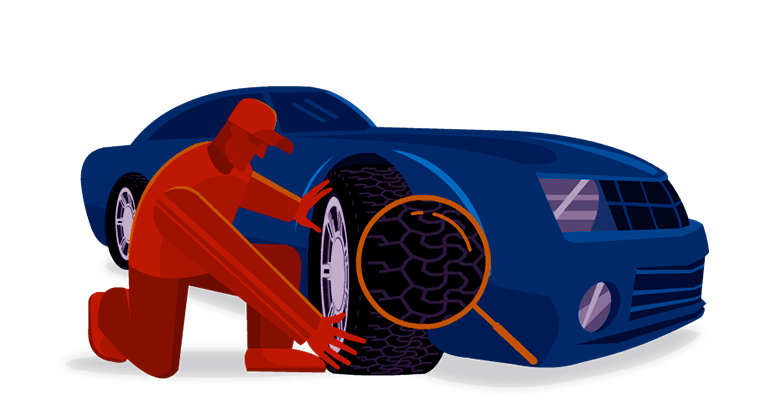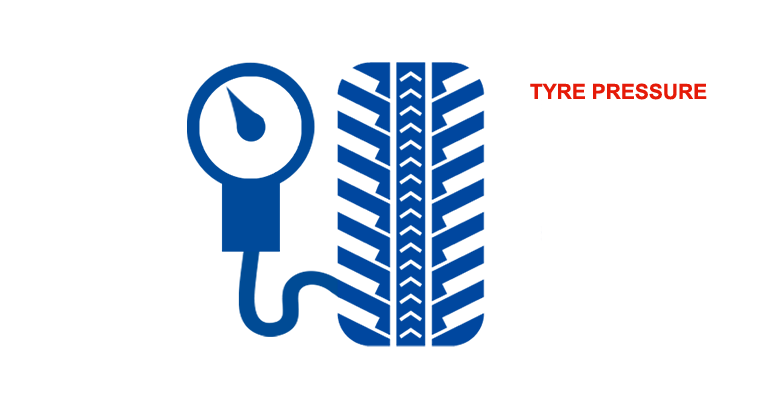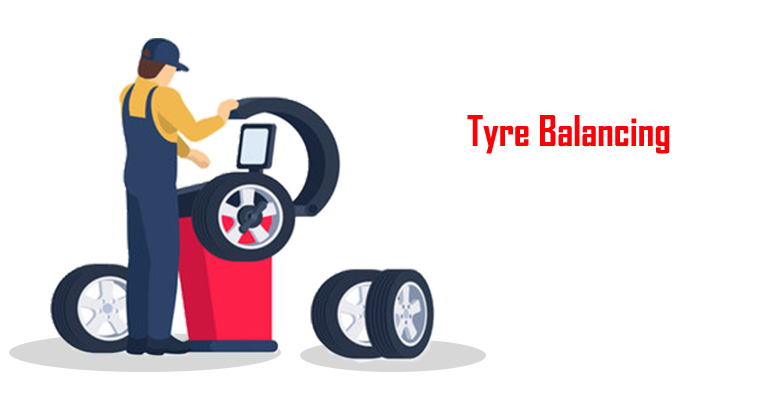Maintaining Correct Tyre Pressure
The volume of air pressure inside the tyre can be a make or break element with respect to the life and safety of a tyre. Right tyre pressure translates into better fuel mileage, optimal braking and handling performance, and longer tyre life. Measured in pound per square inch (PSI), it is the volume of air that goes inside the inner lining of the tyre.
Every vehicle manufacturer recommends the correct tyre pressure for its tyres. Following which, the vehicle enables better stability and grip over the surface. The tyre pressure should be examined at least every fortnight, or before and after any long trip.

Tyre Age:
To ensure prolonged tyre and tread life it is best to keep them in use more often. Tyres age faster when not used and age gradually when they are put to task. The featuring of anti-oxidising chemicals in the compound arrests tyre wear, however occasional use, storage under poor conditions and varying temperature speed up ageing process making tyres unusable. Its infrequent use result in less wear and tear of the tread however may put handling and performance of the vehicle at risk despite sufficient tread.
Identifying tyre ageing is easy, and its accelerated wear can be kept in check with the inspection at frequent intervals. Some of the visible symptoms of tyre ageing include cracks on the sidewall, deep cuts/slits on the tread area, and even minimal tread depth.
Wheel Alignment:
Irregular tyre wear and unsteady handling can be due to incorrect wheel or tyre alignment, which may also put a question mark on the safety of your vehicle. Alignment of the wheel can go unstable if driven over a kerb, abruptly run over a pothole or due to excessive driving under bumpy and off-road conditions.
Wheel alignment is all about setting the tyres in the right direction and at an angle as recommended by the vehicle's user manual. This ensures improved performance and pliant ride quality alongside helps in extracting the maximum from the tyres. The alignment of wheel revolves more or less around the aspects like the toe-in, toe-out, positive camber or negative camber.
The amount by which the front of the tyres is closer or distant against the rear of the tyres is known as 'toe'. The toe setting for each vehicle differs from another and is specified by the vehicle manufacturer in its manual booklet.

Further, the inward or outward lean of a tyre is referred to as the 'camber'. Just like the toe setting, even camber is defined by the vehicle manufacturer. It can get misaligned due to unexpected potholes, drive over pavements, etc. and requires periodic adjustments.
Improper camber setting can lead to unusual and rapid wear of vehicle tyres, wherein premature wear can be witnessed on the inside or outside of the tyre shoulder.
Tyre Rotation
Tyre rotation is a vital exercise and should be performed periodically to extend tyre life and get better performance from your vehicle. Recommended by every tyre maker, it induces interchanging of the tyre position from one wheel axle to another. This prevents premature and the abnormal wearing of the tyres encouraging longer tread life and better fuel mileage.
5 Simple Things That Affect Tyre Life
To function efficiently an automobile requires periodic service and maintenance. Similarly, tyres too, expect regular care for better performance and longer tread lifespan. However, compared to the upkeep of vehicles, tyres are mostly neglected by their owners. Tyres are the only part that is always in contact with the surface and are responsible to provide you with hassle-free driving - if maintained well - or problematic experience due to poor care.
Remember, dismally maintained tyres may leave you stranded in the middle of your journey. And to make sure you do not come across any mishap or malfunctioning of the tyres here are 5 simple points to consider.
Air Pressure

Air pressure in a tyre works towards the uniform distribution of the vehicle's weight across the tyre's tread to furnish optimum stability to the vehicle while driving. Hence, filling the tyre with the right pressure is vital. An over-or under-inflated tyre may negatively affect a vehicle's performance in terms of stability and handling.
Tyres with incorrect air pressure do not last long and wear inconsistently. As a result, always insist upon recommended tyre pressure specified by the vehicle manufacturer.
.png)
Calculated in PSI unit in India, the tyre pressure should be checked twice a month with the fact in mind that a tyre loses 2 psi every month. The escaping of air in a tyre is at a higher rate during hot climate compared to the cold weather.
Advantages of correct air pressure:
Safety - Tyres will never perform up to their mark when they are over-inflated or under-inflated with air pressure. Apart from performance, they may also pose threat to safety due to poor handling, ineffective braking or, at worst, may even result in a tyre blowout.
Fuel Economy - Besides performance, even fuel economy takes a toll when the tyres are not inflated properly. Here, under-inflated tyres demand more force from the engine to pull the vehicle which directly calls for high rolling resistance leading to more consumption of fuel.
Tyre Life - Tyres with inaccurate air pressure are more prone to injuries and irregular wear, which reduce their overall life. Damaged tyres call for immediate replacement leading to unsolicited expenditure.
Alignment
Wheel alignment specs for each vehicle are provided by the OEMs. However, owing to different driving habits and conditions the vehicle's steering response may get affected and become less responsive. This is an indication of a misaligned wheel, which demands immediate attention.
Alignment may get unstable if the vehicle is driven over a footpath or a pothole, or even due to steering/suspension wear. Other issues considering alignment can be vehicle pulling towards left or right during straight-line driving, harsh steering vibrations, etc. Fixing of the wheel alignment problem paves way for confident driving and longer tyre life.
Advantages of correct wheel alignment:
- Tyre and tread life is increased by 30%.
- Improved fuel efficiency of up to 2% can be ascertained.
- Optimum vehicle stability is ensured at high speeds.
- Proper wheel alignment also enhances the handling aspect of the vehicle.
Balancing
Just as an improper wheel alignment can impact tyre life, even incorrect wheel balance can prove to be deceitful for tyres and vehicle performance. When the wheel is off-balance the steering wheel tends to wobble and vibrate during driving. This signals premature wearing of tyres, steering parts and suspension, and other rotating components.

Although wheel balancing is checked and fixed during wheel alignment, it mainly comprises of examining weight imbalance in the wheel/tyre. To fix the balancing issue always rely on wheel balancing machine, instead of manual balancing assessment.
Advantages of correct wheel balancing:
- Smooth and judder-free ride quality is maintained
- Even weight distribution ensures reduced tyre wear due to accurate tyre balance
- Minimum friction of the engine components is warranted
Tread Wear
Every tyre is provided with its last wear limit by the tyre manufacturer in the form of tread wear indicators (TWIs). Using the tyre after the said extent makes the tyre unsafe and untrustworthy with respect to its performance. Usually, every car tyre comes with a tread/groove depth for 8mm, however, with constant use it tends to wear and the depth decreases.
In a tyre's life, the minimum tread depth required to ensure the right amount of grip and water dispersal is of 1.6 mm, which is also the depth at which the TWIs can be found. As a result, to maintain trouble-free drivability free from any risks, it is recommended to swap the old tyres with brand-new ones once TWIs are exposed. You can either check the tread depth with a tread depth gauge or drive your car to your nearest garage and get it examined by a tyre expert.
5 Overloading and High-Speeding
Overloading and high-speeding can always be perilous for you, your car as well as for the vehicles moving alongside. High-speeding coupled with overloading has been a major factor for tyre bursts on the road, and has proved fatal in many instances. And this has often resulted due to tyres with less or no tread depth (tyre ageing).
Besides ageing, tyres burdened with more than their recommended maximum load capacity also result in such a mishap. Each tyre is inscribed with the speed limit and load capability on its sidewall. If driven over that specified speed with more than the prescribed load the vehicle may lose control and tyres could malfunction.